Overcoming The Fear Of Falling
By Neil Ohlenkamp
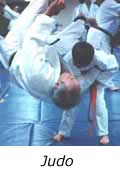 While
everyone has an innate fear of falling, most martial
artists should learn basic falling techniques not
only to avoid injury but to better learn the transition
from standing techniques to those on the ground. While
everyone has an innate fear of falling, most martial
artists should learn basic falling techniques not
only to avoid injury but to better learn the transition
from standing techniques to those on the ground.
The most universal and basic of all fears, across
all cultures, is the fear of falling. Behavioral research
has established that babies are born with only two
natural fears. One is a fear of certain noises and
the other is the fear of falling. Over time people
develop other fears. Many can become critical problems
that disable normal functioning. On the other hand,
most people can also overcome their fears and learn
to cope with them. Learning to deal with the fear
of falling can establish an important sense of confidence
that often will translate into the ability to deal
with other fears.
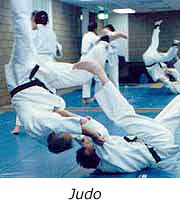
The earliest and most primal fear we experience is
falling, but most people have many opportunities to
fall and realize at a young age that they can survive.
Recreation and sports activities can accelerate that
level of acceptance. Activities as diverse as gymnastics,
football, hiking, and skateboarding provide plenty
of opportunities.
No activity deals with the fear of falling so directly
and positively as judo and many jujutsu systems. Aikido
is similar but places equal emphasis on rolling as
well as initiating falls in response to a number of
joint 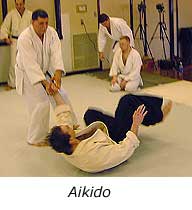 manipulation
techniques. Karate, taekwondo, kung fu and other like
systems also have many tripping, sweeping, take down
and throwing techniques. Some forms of classical Japanese
sword and weapon arts also incorporate foot sweeps
as part of their curriculum. manipulation
techniques. Karate, taekwondo, kung fu and other like
systems also have many tripping, sweeping, take down
and throwing techniques. Some forms of classical Japanese
sword and weapon arts also incorporate foot sweeps
as part of their curriculum.
Richard Carlson, author of "Don't Sweat the
Small Stuff," defines fear with the acronym False
Evidence Appearing Real. In general, fear is an unrealistic
expectation of a negative, usually painful, outcome.
It is often self-perpetuating and difficult to change.
When we fear something we often try to avoid it. Yet
we all know that the way to overcome fear is to face
it, recognize its damaging effects, and begin a step-by-step
process of dealing with it.
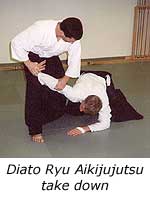
In classes around the world this is typically the
first thing judo, aikido and many jujutsu teachers
focus on with new students. Before people can be expected
to participate in any sports activity involving physical
contact or falling, they should develop certain skills
and learn to overcome their fears so they can feel
comfortable falling. Yet judo, aikido and many jujutsu
systems are unique among sports and martial arts in
the way it incorporates a scientific approach to the
methods of falling called ukemi.
Unfortunately most karate and taekwondo, and kung
fu, neglect proper training in falling or rolling.
This is probably due to the fact that throwing, sweeping,
tripping or takedowns are considered secondary techniques.
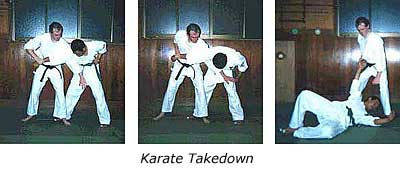
But it is so important to success in any system that
incorporates these techniques that students practice
ukemi (falling techniques) not just when they are
beginning to learn, but as a part of almost every
practice session. This is obvious in judo, aikido
and jujutsu but also important in other arts to avoid
potential injury.
Jigoro Kano, the founder of Judo, explains the importance
of ukemi this way:
"As I have often said if one hates to be thrown,
one cannot expect to become a master of the art. By
taking throws time after time, one must learn how
to take falls and overcome the fear of being thrown.
Then one will become unafraid of being attacked and
be able to take the initiative in attack. Only by
following this manner of training can one learn true
Judo technique."
It is not possible to excel in throwing, or to defend
against an attack successfully, without a thorough
understanding of falling. It is also not possible
to be successful in matwork (ground fighting) without
learning to control the transition from standing to
the mat, the very definition of falling.
The traditional order of training is to move from
the simple to the more difficult. Each person will
progress at his or her own speed but the basic steps
are as follows:
1. At first practice falling or rolling from a low
position, and gradually move higher.
2. Learn one direction and style of falling, then
learn to fall or roll in other directions.
3. First fall or roll in place, then add movement.
4. In the beginning move slowly and carefully, then
increase speed.
5. First fall by yourself, then have a partner throw
you. In aikido learn self-sacrifice throws only after
mastering the basics of falling and rolling. Here
it is often helpful to have a partner assist you.
In Judo or jujutsu when someone is throwing you, repeat
the learning steps 1 through 4 (i.e. start with a
low throw, one direction, no movement, and slow speed).
This step-by-step approach to safe falling, rolling
or self-sacrifice throws sets the stage for developing
confidence, coordination, and control. Learning to
fall properly and safely can be a big step towards
facing some of the other more difficult lessons that
come with intense training. In addition, this method
of learning will immediately transfer well to the
study of your first throws, sweeps or takedowns. For
example, in judo first learn easy throws, in one direction,
without movement, slowly with a cooperating partner.
As you master each element then add other directions,
movement, resistance, etc.
Knowing the importance of ukemi, strive to improve
your skills. Challenge yourself by practicing different
ways to fall, keeping safety uppermost in mind. Constantly
work on developing a fearless attitude that will eventually
allow you to relax and fully enjoy the complete Judo
experience.
Let
Us Know Your Comments & Opinions On This Article

About The Author
Ohlenkamp is a martial arts writer and founder of
www.judoinfo.com.
He is a certified United States Judo Association instructor,
referee, master rank examiner, and master coach (the
highest level of certification), and he was awarded
United States Judo Coach of the Year for 1999. He
holds a sixth degree black belt in Judo and a sixth
degree black belt in jujitsu and has over 31 years
of training and experience in various martial arts
as a competitor, instructor, team coach, and tournament
official.

back
to top
home
| about
us | magazine
| learning
| connections
| estore
|